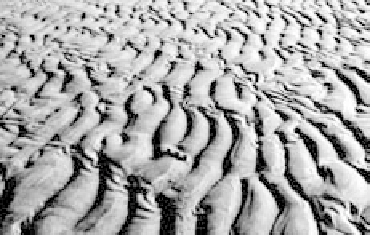Geoscience Reference
In-Depth Information
difficult in air than in water, because of reduced fluid shear
stress and the small buoyancy force. On the other hand the
widespread availability of mineral silt and mud (“dust”)
and the great thickness of the atmospheric boundary layer
means that dust suspensions can traverse vast distances.
5
Energetic grain-to-bed collisions mean that wind-
blown transport is very effective in abrading and rounding
both sediment grains and the impact surfaces of bedrock
and stationary pebbles.
to particular conditions of particle size, flow depth and
applied fluid stress. These bedforms also change the local
flow field; we can conceptualize the interactions between
flow, transport, and bedform by the use of a feedback
scheme (Fig. 4.39).
Current ripples
(Fig. 4.40c) are stable bedforms above
the threshold for sediment movement on fine sand beds at
relatively low flow strengths. They show a pattern of flow
separation at ripple crests with flow reattachment down-
stream from the ripple trough. Particles are moved in bed-
load up to the ripple crest until they fall or diffuse from the
separating flow at the crest to accumulate on the steep rip-
ple lee. Ripple advance occurs by periodic lee slope
avalanching as granular flow (see Section 4.11). Ripples
form when fluid bursts and sweeps to interact with the
boundary to cause small defects. These are subsequently
4.8.4 Flow, transport, and bedforms in
turbulent water flows
As subaqueous sediment transport occurs over an initially
flat boundary, a variety of bedforms develop, each adjusted
1 ry causes
Turbulent
flow
2 ry feedback
Modifications
(+ve and -ve) to
turbulence intensity
Flow separation,
shear layer eddies,
outer flow modification
Turbulent
flow structures
Local transport rate
Transport
Bedform
Bedform initiation and development
Fig. 4.39
The flow-transport-bedform “trinity” of primary causes and secondary feedback.
(b)
(c)
(a)
Fig. 4.40
Hierarchy of bedforms revealed on an estuarine tidal bar becoming exposed as the tidal level falls. (a) Air view of whole bar from
Zeppelin. Light colored area with line (150 m) indicates crestal dunes illustrated in (b). (b) Dunes have wavelengths of 5-7 m and heights of
0.3-0.5 m. (c) Detail of current ripples superimposed on dunes, wavelengths
c
.12-15 cm.






















Search WWH ::

Custom Search